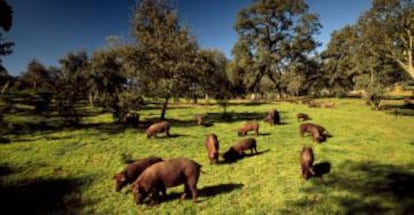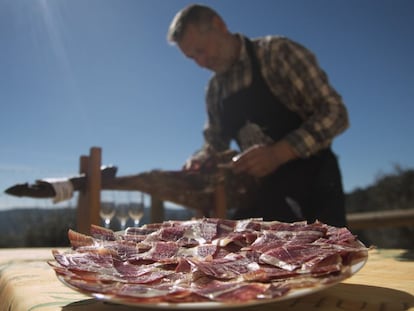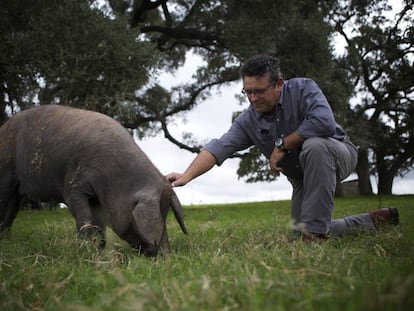The trials and tribulations of Spain¡¯s prized Ib¨¦rico ham
A change in regulations led to a glut of supply, which breeders say is causing a loss of value

Of the many varieties of Spanish pork products, among the most sought-after is Ib¨¦rico de bellota, traditionally produced from the black Iberian pig, which forages for acorns in woodland, giving its cured ham a unique flavor, texture and hue.
For decades, Ib¨¦rico de bellota has been the preserve of family concerns (there are some 14,000 breeders in Spain, supplying almost 700 businesses), but rising demand for gourmet products and new export markets have attracted the interest of Spain¡¯s large meat companies, anxious for a slice of a €1 billion-a-year business.
These companies have lobbied successive Spanish governments to broaden the criteria for defining Ib¨¦rico, and managed to secure a very flexible definition of what constitutes an Iberian pig. This boosted the market supply of products labeled as ¡°Ib¨¦rico,¡± and has angered traditional producers, who fear the exclusive brand is losing value.
You cannot say that a 100% Iberian pig is going to produce the best ham
Ib¨¦rico producer
But breeders of the black Iberian pig that produces pure Ib¨¦rico products note that they have been here before. ¡°Back in the day, white pig breeders managed to appropriate the word ¡®serrano¡¯ for their own products,¡± explains a producer. ¡°And now they are also appropriating the word ¡®ib¨¦rico¡¯.¡±
Food giants such as Argal, Vall Companys, Grupo Jorge, El Pozo and Campofr¨ªo have descended upon the market, especially after Ib¨¦rico products proved to be more resilient than white pig products to the protracted economic crisis.
Traditional producers now accuse the government of caving in to pressure from regional lobbies in Catalonia, Murcia, Castilla-La Mancha and Castilla y Le¨®n, where those large companies are based.
The story goes back two decades, when increased demand for Ib¨¦rico products frayed the relationship of trust between breeders and industry giants. It became evident that there was no clear regulation regarding how to raise and fatten up the breed.
In 2001, the Spanish government addressed the issue by developing definitions for each type of Ib¨¦rico product (especially with a view to the export market). It also introduced control mechanisms and strict quality standards for every part of the process, from animal genetics to sales.

The most radical change involved the break with the dehesas, the oak-filled pastures where black Iberian pigs had always been raised and partly fed on acorns. From that moment on, any animal with one parent that was a black Iberian pig could be marketed as Ib¨¦rico.
Suddenly, a population of under one million Iberian pigs swelled to 4.5 million between 2004 and 2005. Of these, 80% were farm animals raised on grain. This glut, coupled with the economic crisis, drove up supply and pushed prices down. Supermarket chains began offering low-cost Ib¨¦rico products to attract clients. The losses led to a containment of production to around two million pigs, although the number is beginning to rise again on the back of the economic recovery.
To help consumers navigate the confusing world of Iberian products, in 2013 the government released a classification of pork products based on the animal breed and the conditions in which it was raised. A white label is used for ¡°ib¨¦rico de cebo,¡± made from grain-fed pigs; a green label ¡°ib¨¦rico cebo de campo,¡± where animals spend 60 days grazing and eating acorns on a dehesa; a red label for ¡°ib¨¦rico de bellota,¡± who spend the period between October 1 and December 15 on a dehesa, and a black label for pigs who also spend two-and-a-half months on a dehesa and both of whose parents are black Iberian pigs.
That, at least, is the theory. In practice, the industry says that entire ham legs labeled as ¡°ib¨¦rico de bellota¡± are selling for €180, when production costs are upwards of €400. So either this ham is not what it claims to be, or distributors are selling at a loss. Producers say that central and regional authorities are not cracking down on this latter practice sufficiently.
Ultimately, only 6% of total production comes from 100% pure black Iberian pigs raised on dehesas. And these are concentrated in two very specific parts of Spain: Andalusia and Extremadura. Nine out of every 10 black labels come from these two regions.
Pig ID
As if all the labeling were not confusing enough, there are now question marks regarding the purity of the animals themselves. There are 435,000 registered specimens with the Spanish Association of Iberian Pig Breeders (Aeceriber). Around 341,000 of these were incorporated following a 2014 government decree giving breeders two years to register all genetically pure animals. But instead of demanding expensive DNA tests (costing at least €20 a head), the decree authorized the registration with nothing more than a visual inspection by an expert veterinarian.
Aeceriber did not add these new animals to the main register, but to an annex instead. ¡°We only add animals to the main register if we already know the two generations that came before them,¡± says Elena Dieguez, the association president. ¡°Systematic molecular testing would be prohibitively expensive, but if we see something odd, we don¡¯t sign up the animal and we perform random tests.¡±
Dieguez says that the real problem is that products from cross-breeds are being marketed as Ib¨¦rico. ¡°We would have preferred clear, specific numbers: 50% ib¨¦rico, 75% ib¨¦rico and 100% ib¨¦rico,¡± she adds.
Systematic molecular testing would be forbiddingly expensive, but if we see something odd, we don¡¯t sign up the animal and we perform random tests
Elena Dieguez, Aeceriber
The government defends its regulations, and insists that theirs is not a free-for-all policy. Breeders also support the visual inspection, and even note that racial purity is not that important.
¡°You cannot say that a 100% Iberian pig is going to produce the best ham,¡± says a dehesa producer. It¡¯s a very greasy animal. In fact, many of our best animals are a cross between Iberian pigs and other breeds such as the Duroc.¡±
English version by Susana Urra and Nick Lyne.
Tu suscripci¨®n se est¨¢ usando en otro dispositivo
?Quieres a?adir otro usuario a tu suscripci¨®n?
Si contin¨²as leyendo en este dispositivo, no se podr¨¢ leer en el otro.
FlechaTu suscripci¨®n se est¨¢ usando en otro dispositivo y solo puedes acceder a EL PA?S desde un dispositivo a la vez.
Si quieres compartir tu cuenta, cambia tu suscripci¨®n a la modalidad Premium, as¨ª podr¨¢s a?adir otro usuario. Cada uno acceder¨¢ con su propia cuenta de email, lo que os permitir¨¢ personalizar vuestra experiencia en EL PA?S.
?Tienes una suscripci¨®n de empresa? Accede aqu¨ª para contratar m¨¢s cuentas.
En el caso de no saber qui¨¦n est¨¢ usando tu cuenta, te recomendamos cambiar tu contrase?a aqu¨ª.
Si decides continuar compartiendo tu cuenta, este mensaje se mostrar¨¢ en tu dispositivo y en el de la otra persona que est¨¢ usando tu cuenta de forma indefinida, afectando a tu experiencia de lectura. Puedes consultar aqu¨ª los t¨¦rminos y condiciones de la suscripci¨®n digital.










































